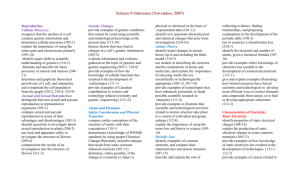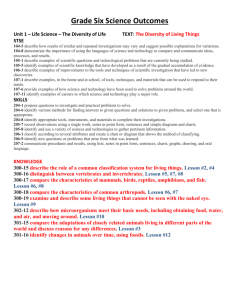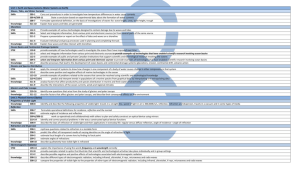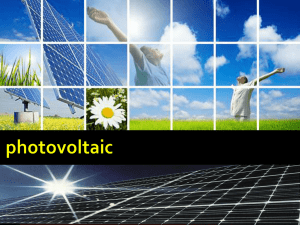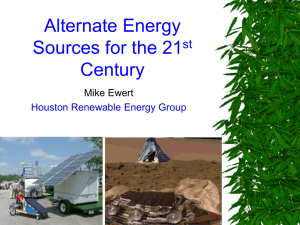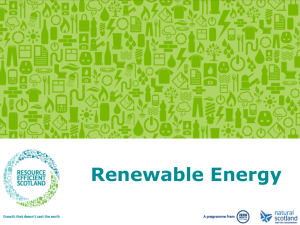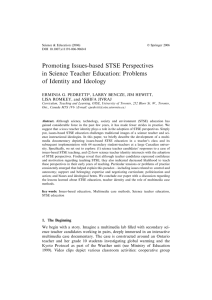9 Unit 1: Life Science (Reproduction) Cellular Processes STSE 109
advertisement
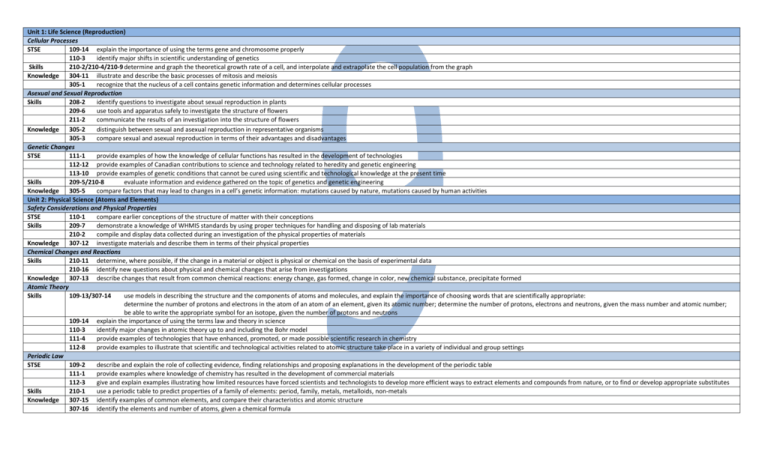
Unit 1: Life Science (Reproduction) Cellular Processes STSE 109-14 explain the importance of using the terms gene and chromosome properly 110-3 identify major shifts in scientific understanding of genetics Skills 210-2/210-4/210-9 determine and graph the theoretical growth rate of a cell, and interpolate and extrapolate the cell population from the graph Knowledge 304-11 illustrate and describe the basic processes of mitosis and meiosis 305-1 recognize that the nucleus of a cell contains genetic information and determines cellular processes Asexual and Sexual Reproduction Skills 208-2 identify questions to investigate about sexual reproduction in plants 209-6 use tools and apparatus safely to investigate the structure of flowers 211-2 communicate the results of an investigation into the structure of flowers Knowledge 305-2 distinguish between sexual and asexual reproduction in representative organisms 305-3 compare sexual and asexual reproduction in terms of their advantages and disadvantages Genetic Changes STSE 111-1 provide examples of how the knowledge of cellular functions has resulted in the development of technologies 112-12 provide examples of Canadian contributions to science and technology related to heredity and genetic engineering 113-10 provide examples of genetic conditions that cannot be cured using scientific and technological knowledge at the present time Skills 209-5/210-8 evaluate information and evidence gathered on the topic of genetics and genetic engineering Knowledge 305-5 compare factors that may lead to changes in a cell’s genetic information: mutations caused by nature, mutations caused by human activities Unit 2: Physical Science (Atoms and Elements) Safety Considerations and Physical Properties STSE 110-1 compare earlier conceptions of the structure of matter with their conceptions Skills 209-7 demonstrate a knowledge of WHMIS standards by using proper techniques for handling and disposing of lab materials 210-2 compile and display data collected during an investigation of the physical properties of materials Knowledge 307-12 investigate materials and describe them in terms of their physical properties Chemical Changes and Reactions Skills 210-11 determine, where possible, if the change in a material or object is physical or chemical on the basis of experimental data 210-16 identify new questions about physical and chemical changes that arise from investigations Knowledge 307-13 describe changes that result from common chemical reactions: energy change, gas formed, change in color, new chemical substance, precipitate formed Atomic Theory Skills 109-13/307-14 use models in describing the structure and the components of atoms and molecules, and explain the importance of choosing words that are scientifically appropriate: determine the number of protons and electrons in the atom of an atom of an element, given its atomic number; determine the number of protons, electrons and neutrons, given the mass number and atomic number; be able to write the appropriate symbol for an isotope, given the number of protons and neutrons 109-14 explain the importance of using the terms law and theory in science 110-3 identify major changes in atomic theory up to and including the Bohr model 111-4 provide examples of technologies that have enhanced, promoted, or made possible scientific research in chemistry 112-8 provide examples to illustrate that scientific and technological activities related to atomic structure take place in a variety of individual and group settings Periodic Law STSE 109-2 describe and explain the role of collecting evidence, finding relationships and proposing explanations in the development of the periodic table 111-1 provide examples where knowledge of chemistry has resulted in the development of commercial materials 112-3 give and explain examples illustrating how limited resources have forced scientists and technologists to develop more efficient ways to extract elements and compounds from nature, or to find or develop appropriate substitutes Skills 210-1 use a periodic table to predict properties of a family of elements: period, family, metals, metalloids, non-metals Knowledge 307-15 identify examples of common elements, and compare their characteristics and atomic structure 307-16 identify the elements and number of atoms, given a chemical formula Unit 3: Physical Science (Characteristics of Electricity) Static Electricity STSE 111-1/112-7 provide examples of how knowledge of static electricity has resulted in the development of technologies 112-10 provide examples of careers related to electricity in their community and province Knowledge 308-13 explain the production of static electrical charges in some common materials 308-14 identify properties of static electrical charges: like charges repel, unlike charges attract, induced charges Static Electricity and Electric Current STSE 109-14/308-16 describe the flow of charge in an electrical circuit and describe the factors affecting the amount of resistance in a wire (length, diameter, type): voltage, resistance, electric current Knowledge 308-15 compare qualitatively static electricity and electric current Series and Parallel Circuits Skills 208-1 rephrase questions in a testable form related to series and parallel circuits 209-3 use an ammeter and a voltmeter to measure current and voltage in a series and parallel circuits 210-7 identify and suggest explanations for discrepancies in data collected using an ammeter and a voltmeter 210-10 identify potential sources of error in ammeter and voltmeter readings 210-5/211-2 present graphically the data from investigation of voltage, current, and resistance in series and parallel circuits Knowledge 308-17 describe series and parallel (maximum two resistors) circuits involving varying resistance, voltage, and current, using Ohms’ Law: – draw circuit diagrams, using circuit symbols for a cell, switch, battery, lamp, resistor, multirange meter Use of Electrical Energy STSE 109-14 explain that precise language is required to properly interpret Energuide labels and to understand a utility bill 110-9 compare examples of past and current technologies that used current electricity to meet similar needs Knowledge 308-18 relate electrical energy to domestic power consumption cost: watt as a unit of power (1W = 1J/s) 308-19 determine quantitatively the efficiency of an electrical appliance that converts electrical energy to heat energy Electricity and the Environment STSE 109-6 give examples of the development of alternative sources of energy (such as wind generators and solar energy) that are a result of cost and the availability and properties of materials 113-9/113-13 propose a course of action that reduces the consumption of electrical energy 113-6/210-8 select recent data while conducting research on the environmental problems associated with various types of electrical energy production Skills 210-8 evaluate evidence and sources of information when conducting research on electrical energy production and its impact on the environment Knowledge 308-20 describe the transfer and conversion of energy from generating station to the home Unit 4: Earth and Space (Space Exploration) The Beginnings of the Solar System Knowledge 312-1 describe theories on the formation of the solar system 312-4 describe and explain the apparent motion of celestial bodies: moon, sun, planets, comets, asteroids Composition and Characteristics of the Solar System STSE Skills 112-6 provide examples of how the Canadian Government and/or Canadian Space Agency is involved in research projects about space 110-6/210-3 explain the need for new evidence in order to continually test existing theories about the composition and origin of our solar system and galaxies 208-4/211-1 in small groups, design and describe a model space station on the basis of what they have learned about the sun’s influences on Earth 211-5 defend their position regarding societal support for space exploration Knowledge 312-5 describe the composition and characteristics of the following components of the solar system: terrestrial and gas planets and Pluto, periodicity of comets, asteroids/meteors 312-6 describe the effects of solar phenomena on Earth: – sunspots – solar flares – solar radiation Composition and Characteristics of the Universe STSE Skills Knowledge 109-3 explain how data provided by technologies contribute to our knowledge of the universe 109-11/111-5 describe the science underlying three technologies designed to explore space 112-11 describe examples of science and technology based careers in Canada that are associated with space exploration 209-4/211-1/211-3 working collaboratively with group members, prepare a comparative data table on various stars, and design a model to represent some of these stars relative to our solar system 210-9 calculate the travel time to a distant star at a given speed: define and explain a light year 210-16 identify new questions and problems that arise from the study of space exploration 312-2 describe and classify the major components of the universe: nebulae, galaxies, giant stars, dwarf stars, quasars, black holes 312-3 describe theories on the origin and evolution of the universe: big bang theory, oscillating theory
